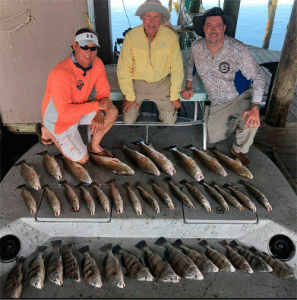 A bad day of fishing is surely better than a good day at work, we all agree. But there are times when you just should not be out on the water. These are times when the wind is roaring out of the North and the conditions for small craft advisories are in affect and everyone thinks you are plain nuts for braving the bay. I whole heartedly agree that you should not be out there but then there are times when experienced boaters and anglers can get around the weather and have a safe day on the water. Further, I have found that with todays shallow running boats you can avoid the majority of these less than perfect rough water conditions and not only survive them but catch some decent boxes of fish by running tighter on the shorelines and avoiding the severe chop of the wind blown swells!
A bad day of fishing is surely better than a good day at work, we all agree. But there are times when you just should not be out on the water. These are times when the wind is roaring out of the North and the conditions for small craft advisories are in affect and everyone thinks you are plain nuts for braving the bay. I whole heartedly agree that you should not be out there but then there are times when experienced boaters and anglers can get around the weather and have a safe day on the water. Further, I have found that with todays shallow running boats you can avoid the majority of these less than perfect rough water conditions and not only survive them but catch some decent boxes of fish by running tighter on the shorelines and avoiding the severe chop of the wind blown swells!
Fish are smart enough to figure out early in the Fall that things will be changing soon and they have a built in survival technique that allows them to take cover when the times come. I can say that of all the winter fishing I have done over the years I spent way too many of those days in 45 degree water temps and a foot or two of water wondering why I wasn’t seeing any bait and dang sure wasn’t getting any fish to bite. Talking to many guides over the years and sitting in on presentations at boat shows and other anglers nights out in addition to running guided fishing trips for over seven years, I realized the best way to learn this is experience gained from others and trial and error on my part. Finally I’m at a point where I sort of understand where to look for these cold water conditions fish!
Concentrate on deep passageways but look for guts coming out of it and adjacent two to three foot flats where the fish can come up to bask in the warming shallower water of a sun filled day but deep enough to provide a quick escape when things go cold on them. Realize these guys are cold blooded and will be moving and eating much slower during these times than what you may be used to during warmer water conditions. Similar to Croaker fishing in the Summer, give the fish that bites your bait a two to three second period of taking the bait in their mouths to be sure you can make a good hook set. Too early on the set and you may miss the fish since they hadn’t had enough time to move their jaw bones enough to eat it. Likewise don’t wait six to ten seconds because if this is a smaller fish or throwback you don’t want that hook in so far it kills the fish to remove the hook. Pay attention to the pace of the bite and let the fish teach you the timing of what to expect on their feeding pattern because they will likely all be on the same program. It’s the angler that can adjust easily and land more fish for the dinner table or enjoy a catch and release day whilst freeing the fish less harmed and able to fight another day!
Enjoy this period of time on the water even with changes in water levels and temperatures. Some of the best ways to learn your bay system is to get out when the water is the lowest. This way you can learn where the reefs begin and end and you can find obstacles in the water that pose a threat to your vessel so you now know how to avoid it. Mark those in your mind and on your GPS and it will give you more confidence the next time the water levels are normal and you are running through the open bay. Customers of mine are puzzled and impressed when I can explain what cannot be seen on the waters surface. Knowing the bottom of the bay floor will help in so many ways and most important will contribute to the safety of your trips and the success of your angling experience.
